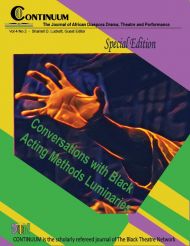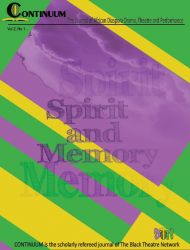“Memory and Spirit”
This third issue of Continuum is an open-ended edition for which we accepted qualified theatre-related articles regardless of specific topics. Serendipitously, all of the articles were concerned in one fashion or another with memory and/or spirit. As African Americans, a people originally ripped from their motherland and subjected to cruel and systematic extermination of their names, languages, cultural beliefs, and spiritual practices, we often highly prize the power and reach of memory. However, our memories are frequently incomplete, illusive, sometimes fabricated and self-protective, but ultimately they are filled with the potential for unearthing unexpected treasures—truths—that can enhance our knowledge, and promote our healing and growth.
Likewise, the connection to Spirit, which is so beautifully described by Melvin Rahming as “the infinite, self-conscious force or energy that originates, drives, and perpetually interrelates everything in the universe” (2013, 36), is also a touchstone of our origins as African people. This aspect of our being was also assaulted during the Middle Passage—assaulted but never extinguished. It manifests itself in a myriad of fashions in the lives of people of the African diaspora, whether in specific structured institutions, such as the Black church or Yoruba cosmology or in the more free-floating sense of connection to something grander than ourselves—an omniscient, omnipotent, omnipresent force that weaves the living, the ancestors, and the unborn into one unbroken tapestry.
In her article, “Regina Taylor’s Crowns: The Overflow of ‘Memories Cupped under the Brim,’” Artisia Green presents a perfect nexus of memory and spirit. Her interpretation of Regina Taylor’s hit play, Crowns, through the lens of Yoruba cosmology and through the Gullah Seeking Ritual unpacks African retentions that reverberate just beneath the surface of this gospel musical as it celebrates the redemptive power of seven “hat queens” (each purportedly owns over 100 hats) on the life of a beleaguered teen-aged girl from the urban North. With firsthand knowledge of the Yoruba belief system, Green guides the reader carefully and compellingly through the connections Taylor also draws between the orisha (divine spirits) and the characters in the play. She particularly delves into three main characters: Man/Elẹ́gbá, Mother Shaw/Ọbàtálá and Yolanda/Ògún, demonstrating how the characteristics of the orisha are manifested in each of the characters respectively. Green completes her analysis by drawing parallels between the play’s structure and the geography of the Gullah Seeking Ritual, whose various stages and progressions are also mirrored in the coming-of-age experiences of the lead character, Yolanda. However, combined with these spiritual and cultural retentions is the healing power of the spoken memories that each hat evokes from the women—the “epistemic testimonials”—that complete the circle and bring Yolanda to wholeness.
Within similar overlappings of spirit and memory, Keith Byron Kirk’sarticle, “Oral History in Performance: Weaving Narrative Identity and Reinventing Malcolm X,” explores the manner in which archival memory, in this case, audio and video recordings, can be manipulated through positioning to actually invent or reinforce false memories of highly charged spiritual events, such as the funeral and commemoration of Malcolm X. Kirk argues that the personal, spiritual, and political border crossings that Malcolm Little/Malcolm X/El Hajj Malik El-Shabazz took in the course of his life made him a particularly complex subject of eulogy and commemoration at the time of his death. Both Christian and Islamic claims were made on his legacy and on the very commemorative activities at his funeral. Marlene Nadel of the Village Voice wrote that his funeral
was a blend of Islamic faith and Christian custom. The priest wore the brown robe and white turban of the Middle East; the widow the black veiling and clothes of western tradition….Flowers are not part of a Moslem’s funeral. Yet Betty Shabazz sent flowers to her husband….Death for a Moslem is supposed to be a private matter. There is not supposed to be any public exhibition of the body, which must not be kept from the grave beyond two sunsets. Yet they keptMalcolm’s body for a full week, and 30,000 people visited Unity Funeral Home and another 3,000 came to the church trying to hold onto the part of them that had died. (1965,1)
It is Spike Lee's depiction of this monumental event in his film Malcolm X that particularly concerns Kirk. By using Ossie Davis's commemorative speech given the day before the funeral and placing it as a coda to the film, Kirk contends that Lee creates a false memory for those who did not witness the event at all, and reinvents the memories of those who may have been alive during that event. In either case, Kirk contends, such manipulation of sound and visuals casts doubts upon the veracity of the event and the archival validity of audio and video recordings as reliable sources of history...and memory.
A funeral event and commemoration also lie at the heart of Rhona Justice-Malloy’s article, “The Florence Mills Association vs. Bill ‘Bojangles’ Robinson: The Contentious Battle over Flo Mills's Monument.” Following the sudden death of beloved Harlem songstress Florence Mills in 1927, the outpouring of grief, represented by the 20,000 who visited her coffin, the 5,000 who packed into Mother of Zion African Methodist Episcopal Church for the funeral, and the 150,000 who stood along the Harlem streets in the pouring rain to watch her funeral cortege, boded well for the realization of her dream of a monument in her honor in Harlem. Using ample references from the “race” papers of the time, Justice-Malloy meticulously documents the birth of a feud between Mills’s good friend and mentor Bill “Bojangles” Robinson and others such as Salem Tutt Whitney whose vision of an appropriate commemoration for Mills differed. Robinson, who hosted and performed many benefits towards the raising of funds for a monument, soon found that others wished to use the funds to create a benevolent society for actors to be named in Mills’s honor. In the midst of the contentious battle, the collective memory failed the community. Despite the extraordinary funeral a mere three years earlier, in 1930 a commemorative event at Mills’s graveside drew only fifty people. While the controversy over the funds, which involved a formal lawsuit, raged on into the 1930s, Robinson was never able to fulfill Florence Mills’ dream of a monument. Today, her stellar artistry has very nearly slipped out of communal memory and into oblivion.
The final article, “Last Sunday: Using Collaborative Playbuilding to Understand Why Some African Americans Leave the Black Church” by James Webb, brings us again to another look at the close intersection between memory and spirit. Webb was perplexed about the motives behind Black people’s decisions to stay with or leave the Black church. Due to firsthand knowledge of Black church politics and from news coverage such as the vitriolic reaction of some Black church leaders to Princeton University Professor of Religion Eddie Glaude’s article, “The Black Church is Dead,” Webb decided to talk to church people “in the trenches.” He chose to design a collaborative playbuilding project as the foundation for his study. In this manner, he was able to involve long-term church members (with deep memories) not only in collecting data about their experiences, but also in analyzing, script writing, attending rehearsals, and participating in a talk-back after the performance. As Dr. Joe Norris, professor of Drama in Education and Applied Theatre asserts, “Stories beget stories, and as conversations unfold there is a flood of information as one person’s account triggers memories in others” (2009, 24). Thus, the
scripted personal memories of church members that stretched back twenty years across a variety of spiritual practices provided unique and unexpected insights into the relationship between Black churches, spirituality, memory, and commitment.
We at Continuum hope this issue will bring you enjoyment and enlightenment as you explore the spectrum of articles that engage and resonate with memory, spirit, and of course, theatre, whether on stage or not.
Works Cited
Nadel, Marlene. 1965. “Burying Malcolm X.” The Village Voice: A Weekly Newspaper of Greenwich Village, March 4, sec. 1.
Norris, Joe. 2009. Playbuilding as Qualitative Research: A Participatory Arts-based Approach. Walnut Creek, CA: Left Coast Press.
Rahming, Melvin B. 2013. “Reading Spirit: Cosmological Considerations in Garfield Linton’s Vodoomation: A Book of Foretelling.” In Literary Expressions of African Spirituality, edited by Carol P. Marsh-Lockett and Elizabeth J. West, 35–62. Lanham, MD: Lexington Books.



